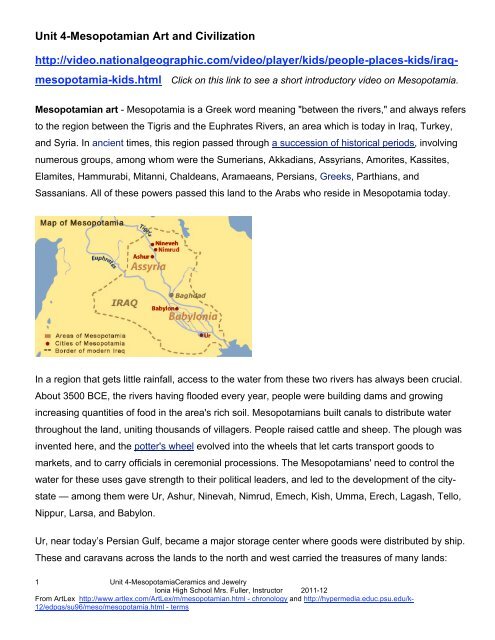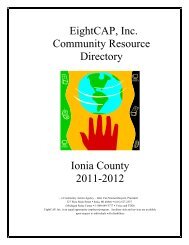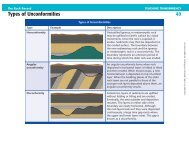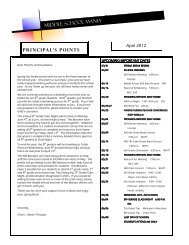Unit 4-Mesopotamian Art and Civilization http://video ...
Unit 4-Mesopotamian Art and Civilization http://video ...
Unit 4-Mesopotamian Art and Civilization http://video ...
Create successful ePaper yourself
Turn your PDF publications into a flip-book with our unique Google optimized e-Paper software.
<strong>Unit</strong> 4-<strong>Mesopotamian</strong> <strong>Art</strong> <strong>and</strong> <strong>Civilization</strong><br />
<strong>http</strong>://<strong>video</strong>.nationalgeographic.com/<strong>video</strong>/player/kids/people-places-kids/iraq-<br />
mesopotamia-kids.html Click on this link to see a short introductory <strong>video</strong> on Mesopotamia.<br />
<strong>Mesopotamian</strong> art - Mesopotamia is a Greek word meaning "between the rivers," <strong>and</strong> always refers<br />
to the region between the Tigris <strong>and</strong> the Euphrates Rivers, an area which is today in Iraq, Turkey,<br />
<strong>and</strong> Syria. In ancient times, this region passed through a succession of historical periods, involving<br />
numerous groups, among whom were the Sumerians, Akkadians, Assyrians, Amorites, Kassites,<br />
Elamites, Hammurabi, Mitanni, Chaldeans, Aramaeans, Persians, Greeks, Parthians, <strong>and</strong><br />
Sassanians. All of these powers passed this l<strong>and</strong> to the Arabs who reside in Mesopotamia today.<br />
In a region that gets little rainfall, access to the water from these two rivers has always been crucial.<br />
About 3500 BCE, the rivers having flooded every year, people were building dams <strong>and</strong> growing<br />
increasing quantities of food in the area's rich soil. <strong>Mesopotamian</strong>s built canals to distribute water<br />
throughout the l<strong>and</strong>, uniting thous<strong>and</strong>s of villagers. People raised cattle <strong>and</strong> sheep. The plough was<br />
invented here, <strong>and</strong> the potter's wheel evolved into the wheels that let carts transport goods to<br />
markets, <strong>and</strong> to carry officials in ceremonial processions. The <strong>Mesopotamian</strong>s' need to control the<br />
water for these uses gave strength to their political leaders, <strong>and</strong> led to the development of the city-<br />
state — among them were Ur, Ashur, Ninevah, Nimrud, Emech, Kish, Umma, Erech, Lagash, Tello,<br />
Nippur, Larsa, <strong>and</strong> Babylon.<br />
Ur, near today’s Persian Gulf, became a major storage center where goods were distributed by ship.<br />
These <strong>and</strong> caravans across the l<strong>and</strong>s to the north <strong>and</strong> west carried the treasures of many l<strong>and</strong>s:<br />
1 <strong>Unit</strong> 4-MesopotamiaCeramics <strong>and</strong> Jewelry<br />
Ionia High School Mrs. Fuller, Instructor 2011-12<br />
From <strong>Art</strong>Lex <strong>http</strong>://www.artlex.com/<strong>Art</strong>Lex/m/mesopotamian.html - chronology <strong>and</strong> <strong>http</strong>://hypermedia.educ.psu.edu/k-<br />
12/edpgs/su96/meso/mesopotamia.html - terms
silver, iron <strong>and</strong> lead from present day Turkey, timber from Syria, semiprecious gemstones such as<br />
lapis lazuli from Afghanistan, <strong>and</strong> gold <strong>and</strong> incense from Egypt <strong>and</strong> Arabia. The <strong>Mesopotamian</strong>s left<br />
us the earliest written records known, when they devised a system of cuneiform writing (marks on<br />
clay tablets made by impressing this plastic material with wedge-shaped ends of carved sticks).<br />
They invented arithmetic (useful in keeping records of sales <strong>and</strong> purchases of goods), built schools,<br />
businesses, temples, palaces, workshops, <strong>and</strong> devised a system for the collection of taxes.<br />
CUNEIFORM: THE BEGINNING OF WRITING<br />
2 <strong>Unit</strong> 4-MesopotamiaCeramics <strong>and</strong> Jewelry<br />
Ionia High School Mrs. Fuller, Instructor 2011-12<br />
From <strong>Art</strong>Lex <strong>http</strong>://www.artlex.com/<strong>Art</strong>Lex/m/mesopotamian.html - chronology <strong>and</strong> <strong>http</strong>://hypermedia.educ.psu.edu/k-<br />
12/edpgs/su96/meso/mesopotamia.html - terms
Click on this link to learn more about cuneiform writing: <strong>http</strong>://www.ancientscripts.com/sumerian.html<br />
Click here to hear a UCLA graduate student describe her experience with a collection of cuneiform<br />
tablets: <strong>http</strong>://www.youtube.com/watch?v=eFGLaFR7le4<br />
Cylinder Seals<br />
2250 Hunting Scene. Mesopotamia. Cylinder Seal is stone. Relief is clay.<br />
A cylinder seal is a cylinder engraved with a 'picture story', used in ancient times to roll an<br />
impression onto a two-dimensional surface, generally wet clay. Cylinder seals were invented around<br />
3500 BC in the Near East at the site of Uruk in southern Mesopotamia. They are linked to the<br />
invention of the latter cuneiform writing on clay cylinders.<br />
Click here to see more cylinder seals <strong>and</strong> read more about them:<br />
<strong>http</strong>://www.ahaafoundation.org/Mesopotamia/Cylinder_Seals.html<br />
Mesopotamia was the setting for such famous Bible stories as the Garden of Eden, the Tower of<br />
Babel (Babylon), <strong>and</strong> the journey of Abraham from the city of Ur.<br />
We actually know little about the <strong>Mesopotamian</strong>s' religion, but much of what we know was learned<br />
from their poetry -- "The Epic of Gilgamesh" is their most important poem. Gilgamesh is one of<br />
ancient Mesopotamia's most legendary historical figures. He was a heroic priest-king from the<br />
3 <strong>Unit</strong> 4-MesopotamiaCeramics <strong>and</strong> Jewelry<br />
Ionia High School Mrs. Fuller, Instructor 2011-12<br />
From <strong>Art</strong>Lex <strong>http</strong>://www.artlex.com/<strong>Art</strong>Lex/m/mesopotamian.html - chronology <strong>and</strong> <strong>http</strong>://hypermedia.educ.psu.edu/k-<br />
12/edpgs/su96/meso/mesopotamia.html - terms
Sumerian city-state of Uruk.<br />
The Sumerians were a religious people <strong>and</strong> had what is called a theocratic culture. They believed<br />
gods ruled the earth <strong>and</strong> that men were created to serve them. They practiced tithing: 10% of their<br />
goods went to the gods. The leader of each city-state was considered a local god who talked to the<br />
head gods. Ur, like every other city-state, had its own head god whose earthly home was the city’s<br />
ziggurat. These temples were built up in layers <strong>and</strong> would tower above the flat l<strong>and</strong> of the area,<br />
reaching to the heavens. The cella, the very top of the ziggurat, is where the communication would<br />
take place between the king <strong>and</strong> the gods. Elaborate rituals would take place at these temples with<br />
priests, servants, <strong>and</strong> worshippers coming <strong>and</strong> going to take care of the god’s every wish. The<br />
ziggurat at Ur was built around 2100 BCE to honor the moon god Nanna.<br />
Click here to learn more about the ziggurat at Ur <strong>http</strong>://www.youtube.com/watch?v=QziF7f87EZ8<br />
The statues found at the Abu Temple in Tell Asmar from c. 2700 BCE are fine examples of the way<br />
Sumerian sculpture is typically based on cones <strong>and</strong> cylinders — arms <strong>and</strong> legs like pipes, skirts<br />
smooth <strong>and</strong> round, flaring out at their bottoms. Faces are dominated by very large eyes; but, for<br />
reasons we might take for granted, artists of many cultures have placed emphasis on eyes.<br />
The sizes of entire figures were also determined by a hieratic imaging system — the most important<br />
people were made the tallest.<br />
Ziggurat at Ur<br />
4 <strong>Unit</strong> 4-MesopotamiaCeramics <strong>and</strong> Jewelry<br />
Ionia High School Mrs. Fuller, Instructor 2011-12<br />
From <strong>Art</strong>Lex <strong>http</strong>://www.artlex.com/<strong>Art</strong>Lex/m/mesopotamian.html - chronology <strong>and</strong> <strong>http</strong>://hypermedia.educ.psu.edu/k-<br />
12/edpgs/su96/meso/mesopotamia.html - terms
In the same vein, a beard on a figure signifed a man in a powerful position.<br />
Two-dimensional depictions generally show figures' heads, legs, <strong>and</strong> feet in profile, while their<br />
shoulders <strong>and</strong> torso are shown frontally, as in this Sumerian painting of a man holding fish, from the<br />
Royal Tombs at Ur.<br />
From about 2300 BCE, wars shaped the future of Mesopotamia's peoples. The Assyrians in the<br />
northern valley of the Tigris River began as a community of peaceful farmers <strong>and</strong> traders. Their<br />
wealth <strong>and</strong> natural resources of copper ore (for arms <strong>and</strong> tools), limestone, alabaster <strong>and</strong> marble<br />
eventually made them targets for the envy of other peoples. The Hammurabi of Babylon, among<br />
others, pressed for control of the Assyrians, <strong>and</strong> eventually Assyrians mobilized fearsome armies to<br />
battle them, among other enemies.<br />
Statues from Abu Temple in Tel<br />
Asmar<br />
5 <strong>Unit</strong> 4-MesopotamiaCeramics <strong>and</strong> Jewelry<br />
Ionia High School Mrs. Fuller, Instructor 2011-12<br />
From <strong>Art</strong>Lex <strong>http</strong>://www.artlex.com/<strong>Art</strong>Lex/m/mesopotamian.html - chronology <strong>and</strong> <strong>http</strong>://hypermedia.educ.psu.edu/k-<br />
12/edpgs/su96/meso/mesopotamia.html - terms
A map of the Ancient Assyrian Empire at three different periods — at its beginnings, little more than<br />
the city-state of Ashur, about 1800-1600 BCE; then when it had gained control of the northern half of<br />
the Tigris <strong>and</strong> Euphrates <strong>and</strong> access to the Mediterranean, 1244-1208 BCE; <strong>and</strong> finally, when the<br />
Assyrians had conquered the entire "Fertile Crescent," including Egypt as far as Thebes, 699-627<br />
BCE.<br />
Assyria's art proudly portrays its pillaging, tearing down cities, <strong>and</strong> the killing <strong>and</strong> submission of its<br />
enemies — partly to intimidate those who might consider fighting back, <strong>and</strong> also because Assyrians<br />
believed that if their conquests passed the tests of the prophets <strong>and</strong> omens, their achievements<br />
would have the blessing of the gods. Ashurnasirpal II at War depicts a successful battles in which a<br />
deity flies above this favored king. The Assyrian Empire reached the height of its size <strong>and</strong> power in<br />
668-627 BCE under Ashurbanipal. Then, under a series of weak rulers, Mesapotamia fell to the<br />
Babylonians.<br />
Ashurmasirpal II at War<br />
Hammurabi was an ancient Babylonian king. He did something that no one had ever done before.<br />
The Sumerians had created the first written cuneiform. Using this written language, Hammurabi<br />
created the first written set of laws.<br />
In Hammurabi's court, it did not matter if you were rich or poor. If you broke the law, <strong>and</strong> were found<br />
guilty, you would be punished.<br />
Since the laws were clearly written down, everyone was expected to obey them.<br />
Click here to read a translation of the Code of Hammurabi:<br />
<strong>http</strong>://www.phillipmartin.info/hammurabi/hammurabi_codeindex.htm<br />
TIGRIS AND EUPHRATES<br />
The Tigris <strong>and</strong> Euphrates Rivers begin in eastern Turkey, flow in a southeast direction, converge in<br />
southeast Iraq, <strong>and</strong> empty in the Persian Gulf. In ancient times, the l<strong>and</strong> between the twin rivers was<br />
called Mesopotamia which was the site of the world's first civilization.<br />
MESOPOTAMIA<br />
Mesopotamia means "the l<strong>and</strong> between the rivers" or "the l<strong>and</strong> between the two rivers." This was<br />
the site of the world's first civilization, Sumer.<br />
CRADLE OF CIVILIZATION<br />
Mesopotamia is often referred to as the "cradle of civilization" because the world's first civilization<br />
occurred there.<br />
6 <strong>Unit</strong> 4-MesopotamiaCeramics <strong>and</strong> Jewelry<br />
Ionia High School Mrs. Fuller, Instructor 2011-12<br />
From <strong>Art</strong>Lex <strong>http</strong>://www.artlex.com/<strong>Art</strong>Lex/m/mesopotamian.html - chronology <strong>and</strong> <strong>http</strong>://hypermedia.educ.psu.edu/k-<br />
12/edpgs/su96/meso/mesopotamia.html - terms
SUMER<br />
Sumer was the world's first civilization. It was located in the southern area of Mesopotamia where<br />
the twin rivers converged. The people who lived in this area were called Sumerians.<br />
CITY-STATE<br />
The ancient Sumerians organized themselves into competing city-states. A Sumerian city-state<br />
consisted of the city, the surrounding mud brick wall, <strong>and</strong> the surrounding farml<strong>and</strong>.<br />
ZIGGURAT<br />
The ziggurat was a temple. It was located in the center of each Sumerian city-state. It housed the<br />
city-state's patron god. The term ziggurat means "mountain of god" or "hill of heaven." Since the<br />
ziggurat was a sacred place, only priests could enter it.<br />
CUNEIFORM<br />
The ancient Sumerians created the world's first writing system known as cuneiform. The term<br />
cuneiform means "wedge-shaped." Sumerian writing is wedge-shaped because of the the type of<br />
instrument that was used to create it.<br />
STYLUS<br />
The ancient Sumerians used a stylus to write. A stylus is a wedge-shaped instrument made out of<br />
reed. The Sumerians wrote on wet clay tablets with a stylus.<br />
EDUBBA<br />
An edubba is a Sumerian school where young boys learned reading, writing, <strong>and</strong> arithmetic.<br />
SCRIBE<br />
After graduating from a Sumerian school, a young man became a scribe, or a writer.<br />
PRIEST-KING<br />
In early ancient Sumerian history, the powerful priests were also the kings of the city-states.<br />
GILGAMESH<br />
Gilgamesh is one of ancient Mesopotamia's most legendary historical figures. He was a heroical<br />
priest-king from the Sumerian city-state of Uruk.<br />
EMPIRE<br />
An empire is a collection of kingdoms under the power of one powerful ruler.<br />
SARGON I<br />
Around 2300 B.C., Sargon I created the world's first empire in the area of ancient Mesopotamia.<br />
Since he was from the northern reaches of Mesopotamia known as Akkad, the world's first empire<br />
was Akkadian.<br />
HAMMURABI OF BABYLON<br />
__About 1800 B.C., the Amorites moved into Mesopotamia. They established their own city-states,<br />
<strong>and</strong> Hammurabi was the king of Babylon. He conquered the Akkadians <strong>and</strong> ruled all of<br />
Mesopotamia. His reign is often described as the "Golden Age of Babylon"because he established<br />
many new reforms.<br />
THEOCRATIC<br />
a form of organization in which the official policy is to be governed by immediate divine guidance or<br />
by officials who are regarded as divinely guided, or simply pursuant to the doctrine of a particular<br />
religious sect or religion.<br />
Interesting lecture on Ziggurats <strong>and</strong> Heiroglyphics: <strong>http</strong>://www.youtube.com/watch?v=TTsSJ-3rf4Q<br />
7 <strong>Unit</strong> 4-MesopotamiaCeramics <strong>and</strong> Jewelry<br />
Ionia High School Mrs. Fuller, Instructor 2011-12<br />
From <strong>Art</strong>Lex <strong>http</strong>://www.artlex.com/<strong>Art</strong>Lex/m/mesopotamian.html - chronology <strong>and</strong> <strong>http</strong>://hypermedia.educ.psu.edu/k-<br />
12/edpgs/su96/meso/mesopotamia.html - terms







